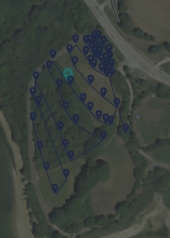
 3
3




 1
1




 2
2




'Theoretically this level of creeping Orwellian dynamics should ramp up our awareness, but what happens instead is that each alert becomes less and less effective because we're incredibly stupid.' - Jerry Holkins
 1
1




when you're going through hell, keep going!





Borislav Iliev wrote:Hi there, I think it is really great coincidence that you are able to visit your property exactly during the dry summer months.
Plant as many trees as you can, and water them, the strong sun during the summer is great but only if you can provide water, otherwise it just kills everything, figuring out how to provide water will be the most important thing imo, since we have that really dry and hot weather here too... during the other seasons your absence wont be that noticed, so dont feel that discouraged because of it.
I experiment with self sufficient aquarium too, I have left the process of formation of soil and I use direct sunlight, my plants are thriving, and everything is really clean(the glass(nerite snails) and the water(clams)). The bottom is a mess according to the general opinion though.




Borislav Iliev wrote:Hi there, I think it is really great coincidence that you are able to visit your property exactly during the dry summer months.
Plant as many trees as you can, and water them, the strong sun during the summer is great but only if you can provide water, otherwise it just kills everything, figuring out how to provide water will be the most important thing imo, since we have that really dry and hot weather here too... during the other seasons your absence wont be that noticed, so dont feel that discouraged because of it.
I experiment with self sufficient aquarium too, I have left the process of formation of soil and I use direct sunlight, my plants are thriving, and everything is really clean(the glass(nerite snails) and the water(clams)). The bottom is a mess according to the general opinion though.








Ella Irati wrote: "it began life as Sheet Total Utter Neglect; plant OODLES of trees and see what lives.."
I want to do that, but like you suggest, have the water works embebed in the design first, it would be too sad for me to eliminate a good oak or fruit tree later on for engineering reasons... I am also experimenting with the idea of getting local small trees from the abundant forests around, specially, I would like to find sweeter oak acorns to to eventually use as food.
Perhaps someone would like to graze their animals over your land, responsibly?[
More than responsibly, traditionally. Y have a neighbour who has been using the field for his sheep, they keep the grass shortish and the field "clean" rotating sheep. I can not tell the neighbour to stop brining in the sheep until I am ready to do something real to the field, or it will become an impenetrable jungle in a couple of years. When I examine the soil (with a clueless city dweller eye), it does not appear to have a lot of humus. It does not retain water either, in the summer, in spite of all the yearly rainfall, grass dries out. Part of the field has this growing, with I keep in mind for the future, as I could enter the weedy area with an automatic saw and use it for hugelkulture or mulch.




 1
1









'Every time I learn something new, it pushes some old stuff out of my brain.'




"Borislav Iliev wrote:Well I am obsessed with chestnuts, so my advice will always include planting chestnuts lol, even if the conditions are not perfect.
"If it was me I would plant seeds from the most expensive big chestnut varieties and also seeds from these old trees that were there for ages, and I will set it so that some crossbreeding can happen(trying to get the best from both), the bad part is it will take very long time, but we should trust the future generations to continue the work."
This is amazing! There are the 500 year old chestnuts less than a mile away (I am attaching a photo) , but about 10 miles up another road, a garden that used to be my grandfather´s has prunes and I am sure I could get permission to get in and get some prunes too. What an amazing idea to mix the most expensive chestnut trees seed and the old one that has proven they are perfect for the area, In the field I have, there is an area that is wild and I could make some clearings and plant trees there, away from the sheep.
"You can make nursery beds for the chestnuts(seeds), pick spots that are between shade and full sun, also it should be a little bit not very obvious place so that they will be spared from the sheep, observe where small trees are already growing, these should be fine spots, dig a hole and fill it with really nice topsoil that you will find under the trees around, it will be hard to do it in the summer though... the best time is to go there when the chestnuts are ready and the ground is a little bit soft from the autumn rain."
I will do this.
"Make as many such spots as possible, you can pick more sunny places, but you should kill the grass there first and to mulch it good so that the grass wont suffocate the small trees, try different places and observe what works, go around the villages and try to find other fine valuable trees and collect seeds, and do the same, you can plant in the same beds, you will transplant them later. Maybe you should not put too many on one spot because you can attract wild animals."
And this.
"My dream land(which I dont have), is something like yours, but close to a river so that I can water the plants when the sun is stronger, our winter is very cold and not really perfect for chestnuts, but northern Spain sounds really great! "
This land is on the border of an artificial lake that feeds the town of Pamplona ( of the running of the bulls fame) with water. I do not have access to the water, but I am hoping to make the land become a sponge and keep the water in it. Have you tried the groasis Growboxx? https://www.youtube.com/watch?v=HRF2bUBPA90 I am obsessed with them and just want an escuse to use them. The North of Spain is where my family comes from, and I want to go back there.
Tell me about your obsession with chestnuts. I thought nothing could compare with oak, it is the only wood we can build with and is not eaten by insects within 10 years in this area. But I am willing to catch another obsession!
"Here is a nice video about chestnuts




F Agricola wrote:Hello Ella,
I am in a similar situation with properties and timelines: largish urban garden in a ‘Temperate’ climate, and a rural property in ‘Subtropics/Tropics’ about an eight hour plus drive away – far enough to make a difference, but not something to do frequently i.e. need at least a week to travel, organise stuff, get things done, then travel again – hectic when working full time.
However, it is perhaps the easiest combination if you’re lucky enough to have two sites – one urban Permiesque garden, and a rural property being developed into a fully pimped Permie garden.
The major issue is keeping on top of the workload - it is hard work to establish, and regardless of what some people say, it is very time-consuming to maintain two properties particularly when there is significant distance between sites.
Other things also need to be considered, like the cost to keep multiple sets of tools and other resources on each property, unless you have a truck/van capable of ferrying all required gear between properties continuously.
The workload and travelling becomes more problematic as people age/health unexpectedly deteriorates.
Frankly, it would be much easier to have one site that ticks most boxes and develop it with all resources focused rather than spreading it out and (realistically) doing a half-baked job at both locations.
The caveat being, if you intend to develop one and use it as an investment e.g. in later retirement, sell one as an established Permie garden.
Obviously, with very careful planning and design it can be done, but it may seem like a fulltime job rather than ‘retirement’.
Spain is a popular place at the moment and attracting people to assist you may not be a bad idea e.g. you could consider getting assistance via the WWOOFer network = World Wide Opportunities/Willing Workers on Organic Farms. That would fast-track progress – especially if you are a good cook!
Enjoy the challenge and best of luck!








Ella Irati wrote:
I worry a little about the illness that wiped them out. What do you know about it? There are many tree illnesses that are attacking trees all over Spain, but I have not heard of anything that attacks chestnuts.
Ella Irati












Christina Mulchmuch wrote:This is a magnificent conundrum. I don't have any advice, but I love the problem and learned a lot reading the replies and watching the Chestnut video.




Borislav Iliev wrote:Hi Ella
Yes for sure looking after every species the way nature intended cant be wrong, after all every species exist exactly because it is doing something very specific in the best way there is, so thats what is earning its
Here people have planted a lot the horse chestnut, as a decoration tree, you can see it all over the city, the trouble is in the end of summer its leafs are all sick and dead, it is some disease, but in some places it is not the case, the difference is that they are being provided some water.
It is exactly like humans, bad nutrition, stress, lack of other essential things will rise the chance for developing or catching any disease there is.
Planting trees from seeds is really the long term solution of problems, I understand well I may not benefit from it myself, for me the end product of raising plants(the food) is not the most important thing, otherwise using grafted varieties and poison makes the most sense(its how most people see it).
.

|
Happiness is not a goal ... it's a by-product of a life well lived - Eleanor Roosevelt. Tiny ad:
Learn Permaculture through a little hard work
https://wheaton-labs.com/bootcamp
|




